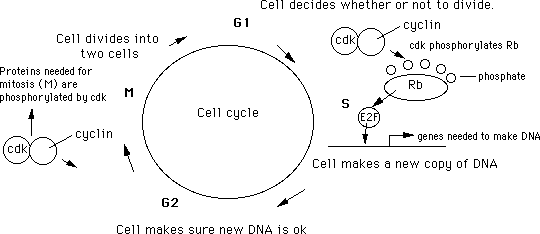
| MadSci Network: Cell Biology |

The cell cycle is a complex and carefully controlled series of events that
allows cells to grow and divide when they should (for example, in a growing
baby) and not when they shouldn't. Cells that escape from cell cycle
control, and divide whenever they want to, can become cancer cells. The
cell cycle is divided into 4 phases. During G1 (or gap 1) cells grow in
size, and respond to signals from outside the cell. These signals
(sometimes called growth factors) will tell the cell to divide, or to keep
hanging out in G1. Some cells, like nerve and muscle cells, never divide
and spend their entire lives in G1.
The next phase of the cycle is S phase, during which DNA is synthesized, or replicated. In order for the cell to divide into two cells, two copies of DNA are needed, one for each cell. During G2, the cells "check" the DNA to make sure no mistakes were made. Mistakes in DNA are called mutations, and can be very bad for the cells (and the person!) if they are passed on. After G2, the cell progresses into M phase, mitosis, during which chromosomes condense, and become separated by the mitotic spindle. At the end of mitosis two new cells form by cytokinesis.
Now, how are these events controlled? Many researchers (like me!) are trying to answer that question, and it turns out to be pretty complicated. Don't worry about the abbreviations-some of them can be pretty cryptic. I've presented a "Cliff-notes" view in the figure above. Using it, I think I can also answer part of your question about the cdks.
The cdks are a type of protein called "kinases". Kinases are proteins that phosphorylate (stick phosphate groups on) other proteins. Phophorylation can switch proteins on, or off, depending on the protein. The cyclin dependent kinases, or cdks, are the proteins that drive the cell cycle. You can think of them as the engines that drive the cell cycle. In order to be active (able to stick phosphate groups on other proteins) they have to have a partner, called a cyclin. You can think of the cyclin as the gas for the cell cycle car. Even though the car has an engine (cdk), and gas (cyclin), it is still stuck in G1 because the brakes are on. The "brake" of the cell cycle is the retinoblastoma protein (Rb). Rb holds onto another protein, E2F, which is necessary to make the proteins which will allow the cell to enter S phase. As long as Rb holds onto E2F, it can't turn on S phase genes. The cdks phoshorylate Rb, which turns it off. Rb then lets go of E2F, and E2F makes S phase genes turn on. After the cell escapes from G1 into S phase, it is usually going to go through the whole cell cycle and make two cells. (If there is DNA damage, the cell can stick in G2.) The cdks are also important in mitosis (M). They phosphorylate many proteins that are necessary for cells to separate their chromosomes and divide.
For more information, check out these great sites:
Virtual
Mitosis
Cell cycle and
mitosis
Cell
cycle and mitosis tutorial (really good!)